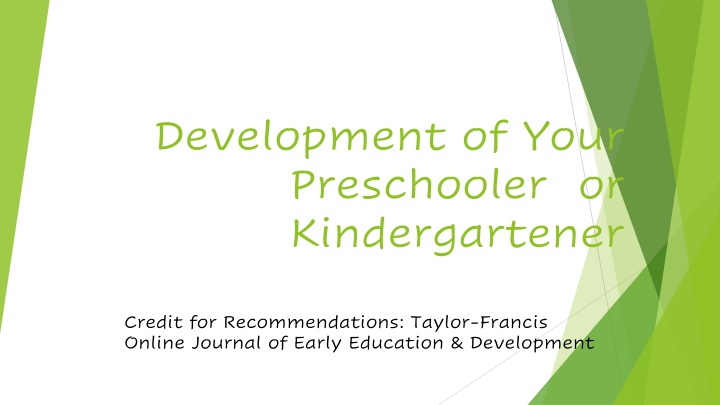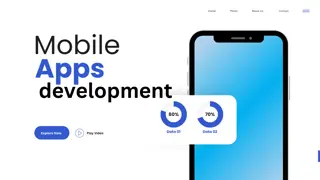
Enhancing Cognitive and Physical Development in Preschoolers and Kindergarteners
Explore the cognitive and physical development of preschoolers and kindergarteners, focusing on autobiographical memory, fine motor skills, and self-help abilities. Learn effective strategies to support memory development and enhance motor skills in young children.
Download Presentation

Please find below an Image/Link to download the presentation.
The content on the website is provided AS IS for your information and personal use only. It may not be sold, licensed, or shared on other websites without obtaining consent from the author. If you encounter any issues during the download, it is possible that the publisher has removed the file from their server.
You are allowed to download the files provided on this website for personal or commercial use, subject to the condition that they are used lawfully. All files are the property of their respective owners.
The content on the website is provided AS IS for your information and personal use only. It may not be sold, licensed, or shared on other websites without obtaining consent from the author.
E N D
Presentation Transcript
Development of Your Preschooler or Kindergartener Credit for Recommendations: Taylor-Francis Online Journal of Early Education & Development
Cognitive Development Autobiographical Memory Autobiographical memory is one of the final stages of cognitive development in preschool important for moral reasoning and recalling important information about how the child has related to peers and adults in specific situations. To summarize, it is the ability to recall a sequence of events that happened in a specific activity and had an emotional effect on the child while also considering the perspectives of the other adults and children during the event and making clear connections to their choices and natural events and the effects or consequences of these causes. Bonus: Ways to Promote Memory Development and Cognitive Awareness: Supporting a child s reflection, by flexibly asking new questions of a make-believe play or real-life story experience can help children recall important elements of an entire event and discuss the steps taken for something to reach a climax, therefore increasing memory and understanding of other participants reactive behavior to different choices
Process of Developing Autobiographical Memory Children begin perceiving emotional cause and effect situations and realize consequences of how certain words, tones or actions effect others negatively or positively at 2 years old. Imaginative play enhances this capability as well. At 3 or 4, kids participate in cooperative and side by side make-believe play and everyday discussion considering the perspective of others, while learning about real-life model toys they are playing with. They learn how to socialize with a new person to develop a common task-focus, often remaking a plot line they are using to tell a make-believe story with over and over, countering each other when one says or represents an situation against the other s knowledge or sharing mental scripts of familiar events relating to nearby play areas. In kindergarten, their self-concept, inhibition and attention span improves with this practice, you ll seen they remember in a thorough sequence certain special/enjoyable events with others natural reactions and initial responses as well. This enhances one s memory. 1. 2. 3.
Physical Development: Fine Motor Self-Help Skills Children begin to utilize utensils in a very basic way, i.e. using a spoon to scoop soft ice cream at age 2-3 & can zip large zippers and put on scarves, t-shirts, and other simple items of clothing. Around age 4 and 5 children can use a fork to eat, dress and undress without supervision, and use a spoon very well to eat different foods By graduation, age 6 , children can cut soft food with a knife and tie their own shoes. Helping Your Child: Working with your child and friends in a small group on fine motor tasks allows kids to scaffold different ways of putting objects together or manipulating them off each other, while being more comfortable asking for guidance from the group leader (you), often times preschools have after school programs where this type of volunteering is requested 1. 2. 3.
Why skill development is awesome! Ability to dress themselves gives preschoolers affirmation of self competence and another outlet for self expression! When children master shoe tying and motor skills related to make-believe (like using silverware), they gain a sense of competence with satisfaction from learning a new life skill that helps them play with other children more easily. Additionally, being able to handle food utensils properly and tie shoes is a result of effortful control of emotional impulse with persistence that enabled master of more complex motor skills this effortful control predicts achievement & social ability throughout schoolyears!
Language Pragmatics Language pragmatics refers to the social adaptation of language to fit the knowledge level, age and social status of your listener developing at age 3. Early preschool children have a steadily increasing vocabulary which expands to allow them to speak back and forth in full sentences with teachers and caregivers when role playing as them in make-believe. Greater understanding of the physical and mental perspectives of adults and children through role changing, resolving conflict and listening and more knowledge of their physical world leads to quick adaptation to the other speaker/listener. They also become better at subject-verb agreement and adapting their speech to a listener s knowledge base at this age. Practice Pragmatically- supporting your child s initiatives at creating and explaining new rule bound role playing games, helping them understand people have common goals and different personal desires based on knowledge of varying character needs that change the way they present their ideas while showing cause and effect and relationships between game rules, character and choices, then help them reflect on small new rule change/s they created and the results of how its affecting their character-role playing choices in the game that they will vocalize next play session
Social Problem- Solving, related to Autobiographical Memory When engaging in play with other children, settling a minor conflict, or approaching a classmate, children are constantly engaging in instinctive and conscious level inferencing that helps them make decisions to have a good relationship with peers this is social problem solving. This skill does not come overnight; in fact, it does not develop until age 5-6. Early play experiences help children empathize with other children s plights to join in play, with other children s plights to join in play, needs for consoling during a painful experience needs for consoling during a painful experience and imagine what the other child is thinking or wanting based on knowledge of cause and effect emotional understanding with multiple cooperative make-believe experiences. empathize Important to Know: offering a variety of avenues for play (physical, role-playing and artistic) allows them to make sense of their many strengths and playmates behaviors






















